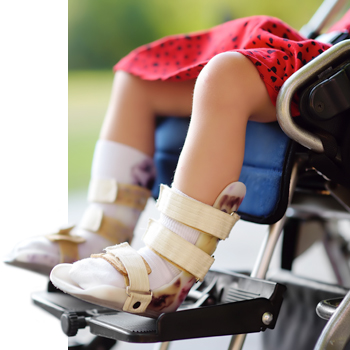
There are many ways to classify your child’s cerebral palsy (CP) diagnosis. One of the most common is by the way this condition affects your son or daughter’s motor functions.
Below, the trusted cerebral palsy attorneys at Janet, Janet & Suggs, LLC review the different types of motor function classifications of CP along with common symptoms.
If your child is suffering from one of these types of cerebral palsy, it may have been caused by negligence during childbirth and our attorneys may be able to help you recover compensation. Contact us today to review your legal options.
Spastic Cerebral Palsy
This is the most common CP diagnosis, as approximately 70 to 80 percent of people with CP have this type.
This condition is characterized by an increase in muscle tone that causes muscles to be stiff and resistant to flexing or relaxing, making it harder to control movements. Children with spastic CP often have poor balance and coordination and struggle with eating and talking.
Spastic CP can also result in other disabilities, such as hip dislocations, scoliosis and deformities in the limbs.
There are five types of spastic CP, based on the limbs that are affected:
1. Hemiplegia
This is a condition affecting one arm and leg on one side of the body.
2. Diplegia
This is also called paraplegia, because it affects both legs and not the upper body. A common symptom of this type of CP is the legs crossing at the knees, making walking very difficult.
3. Monoplegia
This is when the child experiences CP symptoms in one arm or leg.
4. Quadriplegia
This is a condition affecting both arms and both legs, along with the trunk, mouth, tongue and windpipe. Babies with this form of CP often experience the following symptoms:
- Trouble swallowing and sucking
- Weak or shrill cry
- Lack of interest in what is happening around them
- Tendency to startle easily
- Tendency to sleep often
- A floppy or very stiff body
Children with this diagnosis take a lot longer to reach developmental milestones, like walking and crawling. In some cases, children with this form of CP experience incredible pain that makes them not want to learn how to walk.
5. Triplegia
Children receive this diagnosis when one leg and both arms are affected or when both legs and one arm are affected.
Non-Spastic CP
This is a form of CP characterized by decreased or fluctuating muscle tone. Some children with this condition display repetitive or rhythmic movements, while others have slow or fast movements.
There are two main categories of non-spastic CP:
1. Dyskinetic
This is a condition where muscle tone fluctuates between tightness and looseness. Some children experience involuntary movements that are rapid, jerky, or slow and continuous. These movements often occur in these areas:
- Face
- Neck
- Hands
- Feet
- Arms
- Legs
- Torso
There are two types of dyskinetic CP:
Athetoid
Although children with this form of CP are often intellectually adept, they have a variety of physical issues and limitations. For instance, the face and mouth muscles could be affected, resulting in odd facial expressions, drooling and choking when drinking or eating. Children may also experience involuntary jerking during sleep and involuntary contractions in the arms, legs and hands when they are awake.
Dystonic
This is characterized by the neck and body being held in a stiff position. The child’s muscles may also experience slow, writhing movements that are involuntary.
2. Ataxic
This is a rare diagnosis and it involves the entire body. Children may experience abnormal movements in various parts of the body, including the torso, hands, arms and legs.
Children with ataxic CP often have problems in the following areas:
- Balance
- Precise movements, such as reaching for objects
- Coordination, such as walking with the legs in awkward positions
- Hand control, which causes problems buttoning shirts and writing
- Control of eye movements, which affects depth perception
Mixed CP
There are also cases where children have a mix of different types of CP. For example, a child could have symptoms of dystonic CP while having monoplegia.
Schedule a Free Legal Consultation Today
The leading cerebral palsy lawyers at our firm have decades of combined experience recovering fair compensation for victims of negligence, including negligence during the childbirth process that resulted in children being born with cerebral palsy.
If you believe your child’s diagnosis was caused by negligence and could have been prevented, contact our attorneys today for a free consultation.
We take cases on contingency, so you will not be charged legal fees unless there is a favorable resolution of your claim.
Contact our firm today to find out if we can help you.
RELATED POSTS
Cerebral Palsy Settlements
